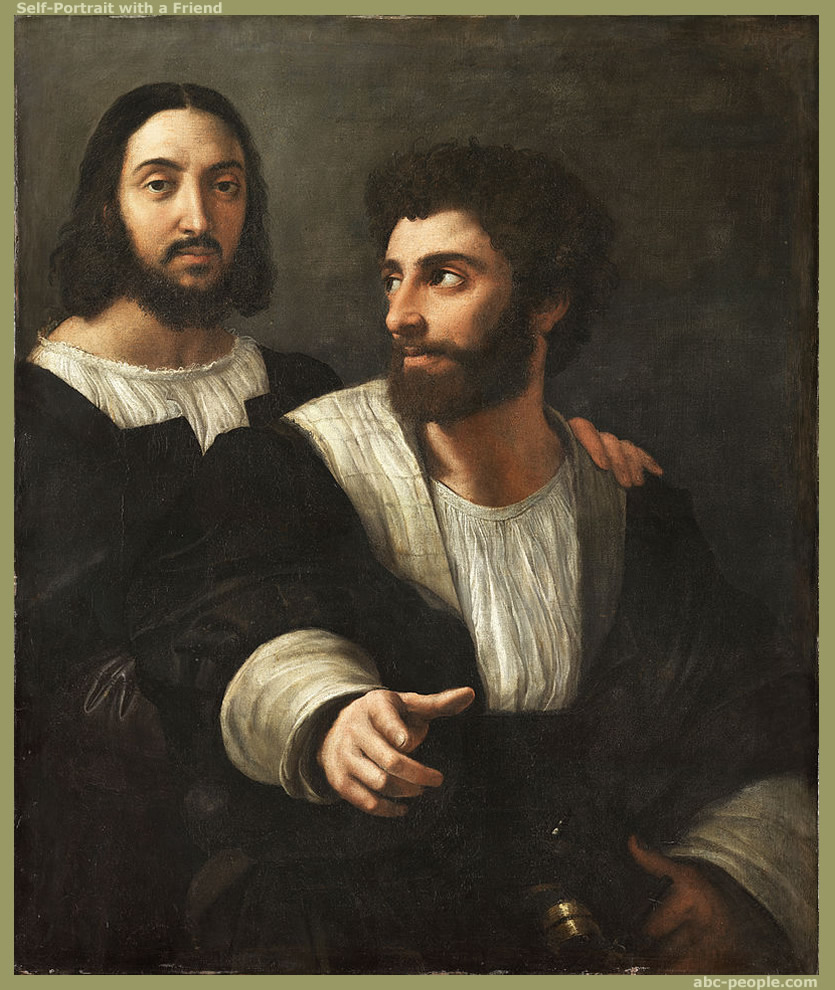| Creativity,
painting, art of Raphael Santi |
|
Self-Portrait
with a Friend |
|
Raphael |
The Self-Portrait with a friend (also known as Double Portrait) is a painting by Italian High Renaissance painter Raphael. In this double portrait the artist himself stands behind an unknown man (a friend or a pupil, perhaps Polidoro da Caravaggio or Giovanni Battista Branconio, for whom Raphael had built Palazzo Branconio dell'Aquila, a palace next to St. Peter's Basilica, in 1518), on whose shoulder his hand rests familiarly. Raphael looks out of the picture with a serious expression. The friend's gesture is not meant for the onlooker, but seems more directed at Raphael, as if he were showing him something himself, perhaps, in a mirror. |
The
identity of the man portrayed before Raphael is unknown. The ancient
tradition identified him as his fencing master, since he holds the
hilt of a sword. Modern art historians consider him one of the painter's
pupils (perhaps Polidoro da Caravaggio or Giulio Romano), a friend
and commissioner of the painting, such as Giovanni Battista Branconio,
for whom Raphael had designed, in the Borgo quarter of Rome, the
now destroyed Palazzo Branconio. Other people associated with the
character include Pietro Aretino, Baldassarre Peruzzi and Antonio
da Sangallo the Younger, as well as other painters such as Il Pordenone
or Pontormo, but these hypotheses have been refuted by other portraits. |
| In this double portrait—a type fairly uncommon in the Renaissance—Raphael paints himself with a young man who holds a sword at his side. Early descriptions sometimes refer to the younger man as the artist’s fencing master, but that identity is questionable given that his fine dress and sword are signals of his aristocratic status. He is likely to have been a friend of high rank. Raphael, however, depicts himself in a position of superiority, standing above his companion and placing a proprietary hand on his shoulder. |
| The
rapid development of Raphael's art overall effected the forms of his
portraits which, by the end of his life, had evolved from the contained
forms of the early Renaissance to bold proto-baroque statements, infused
with complexity, movement, and extreme contrasts of light. His last,
and perhaps greatest, work in the genre, Self-Portrait with a Friend
(Louvre, Paris), c. 1518-1519, is dominated by dark, monochromatic
tonalities, strong contrasts of light and shade, and dramatic action.72
Cladding himself and his unknown companion in severe, albeit elegant,
black silk over white linen, Raphael eschewed the warm browns and
greys of Castiglione's likeness, with which this work, equally personal
and equally communicative, should be linked. Marcia B Hall. The Cambridge companion to Raphael. |
| Our
frontispiece, which reproduces the painting by Raphael conventionally
titled Self-Portrait with a Friend (c. 1518-19), fits the essays gathered
here in that the figures, both the young man pointing out of the frame
of the painting and the standing man behind him, disrupt conventional
symmetries of friendship at the same time that they draw upon them.
The soft fluidity of the seated man's glance back to the standing
figure and the tender relaxation of the latter’s left hand upon
the other’s shoulder bespeak the friendship of two men. Yet
the visual presentation shows friends who are not the same. Although
their garments arc similar in type and color, their posture, facial
expression, and animation differ markedly. The figures differing positions and heights skew the line of sight between them and amplify the sense of asymmetry. One may follow the visual angle from the seated man’s extended hand back to the standing companion, this line not quite parallel to the diagonal one extending from the painting’s upper left comer through the subjects eyes to the fluid cornea and sclera of the seated figure. The latter, together with the extended hand, is also a focus on a vertical axis that implies a third dimension extending from the background up to or adjacent to the position of the viewer. Unlike most early modem double portraits, wherein both subjects face the viewer, here only the standing image of Raphael does so, with the seated figure mediating between him and the unseen object of attention in the foreground. Although the subjects’ gestures convey an intimacy, benevolence, and affection associated with friendship, the lack of visual symmetry heightens the difference between them and, literally, points to a surrounding context, thereby offering an implicit alternative to the closed loop of mutual regard that typified Greco-Roman ideas of true friendship. Daniel T Lochman; Maritere Lo´pez; Lorna Hutson. Discourses and representations of friendship in early modern Europe, 1500-1700. |
| |
|
| Copyright
© 2004 abc-people.com Design and conception BeStudio © 2014-2023 |

